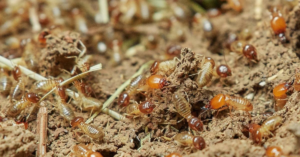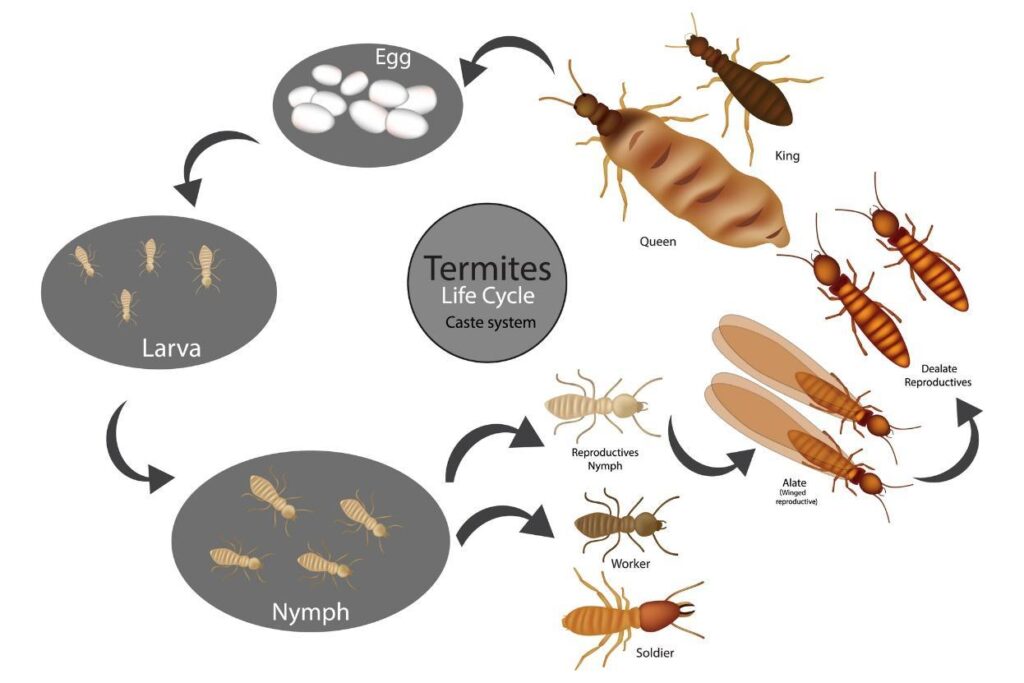Physical Address
23,24,25 & 26, 2nd Floor, Software Technology Park India, Opp: Garware Stadium,MIDC, Chikalthana, Aurangabad, Maharashtra – 431001 India
Physical Address
23,24,25 & 26, 2nd Floor, Software Technology Park India, Opp: Garware Stadium,MIDC, Chikalthana, Aurangabad, Maharashtra – 431001 India

Climate change is the long-term shifts in temperature, precipitation and other atmospheric conditions. The main contributor to climate change is greenhouse gas emissions.
Greenhouse gasses such as carbon dioxide and methane trap heat in the earth’s atmosphere, leading to global warming and resulting in various impacts such as rising sea levels, extreme weather events and ecosystem disruptions.
As we all know, fossil fuel burning, deforestation, and agricultural practices such as livestock farming, industrial processes, and waste management are well-known GHG-emitting methods. But have you ever heard about how termites contribute to GHG emissions?
Termites and Greenhouse Gas Emission
Termites are insects considered social animals and known for their ability to break down cellulose from wood and other plant materials, making them essential decomposers in ecosystems. They live in colonies organised into castes, including workers, soldiers, and reproductives.

Termites construct elaborate nests, often underground or within wood structures, using a combination of saliva, soil and faeces. While they benefit natural ecosystems by recycling nutrients, termites can also be destructive pests, causing damage to buildings and wooden structures.

The other main exception being a pest is their contribution to greenhouse gas emissions. Their ability to break down cellulose releases methane, a potent greenhouse gas, as a byproduct of their digestive process.
Greenhouse Gas Production in Termites
Cellulose is a complex carbohydrate found in plant cell walls. Not all the animals in the world can digest this cellulose. Ruminants such as cows, goats, and sheep can break down cellulose in the plant materials that they consume. As a result of this digestion, they release methane as a byproduct to the atmosphere.
Except for these ruminants, termites are unique animals with that ability. Termites break down cellulose through symbiotic digestion, which involves a partnership between the termites and microorganisms in the gut.
Termites consume cellulose-rich plant material, such as wood or grass, which enters their digestive systems. In the termite’s hindgut, cellulose is fermented by a diverse community of microorganisms, including bacteria, protozoa and fungi. These microorganisms produce enzymes called cellulases, which can break down the complex cellulose molecules into simpler sugars, such as glucose. The termites absorb these simple sugars and other nutrients, released during cellulose digestion through their gut wall, to provide energy to the termites’ metabolism and growth. As a byproduct of microbial fermentation, termites produce and release methane gas through their excretory system. Here to read more on the cellulose digestion process of termites.

How does this Methane Contribute to Climate Change?
Termites are small insects ranging from 3mm to 1 inch long, depending on the species. How much methane released from a tiny termite contributes to climate change is questionable.

One termite produces, on average, about half a microgram of methane per day. This may seem insignificant, but there is a wide distribution of termites in the world, and they are present in 70% of the world’s countries. There are 2972 termite species classified currently. So, with such a large species count and population sizes, approximately 20 million tons of methane comes out of the rear end of these termites annually.
Methane is a potent greenhouse gas, with a much stronger warming effect per molecule than carbon dioxide over a shorter period. Methane is more than 28 times as powerful as carbon dioxide at trapping atmospheric heat. Here, learn more about methane as a greenhouse gas.
Globally, termites are estimated to be responsible for 1% to 3% of global Methane emissions. This is a considerable amount that many do not have an idea about.
Why Are Termites Important to the Earth?
Termites are essential for several reasons.
Overall, termites play a crucial role in maintaining the balance of ecosystems and supporting the health of various plant and animal species. Here for more on termites’ importance.
Damages from Termites
The disadvantages of termites primarily revolve around their potential to cause damage.

While termites serve critical ecological functions, their ability to cause damage to human-made structures and crops can pose significant challenges and economic losses.
Controlling Methane Emission from Termites
As termites are considered household pest types, humans use different methods to avoid and destroy them. But killing them is not a sustainable method. Termites also have their values on earth, and they also need to be protected.
Also, the most common method of getting rid of termites is using chemicals. But these chemicals can be harmful in one way to human and other insects’ health and the environment. Incorrect application and dilution processes can pose harm to humans with health risks. Also, environmental balance and ecosystem water sources can be damaged by these chemicals. So, using sustainable methods in controlling termites is very important.
However, reducing termite methane emissions sustainably can involve several approaches.
Combining these strategies makes it possible to reduce termite methane emissions while promoting sustainable pest management practices.
Conclusion
Termites release methane as a byproduct of the cellulose breaking down process in their guts. This cellulose breakdown process is sometimes helpful in several ways. But
Termites` methane emissions contribute to 1 to 3% of global Methane emissions annually. But to eliminate this issue, destroying termites is not the solution. The best way to balance the situation is to apply sustainable practices on termite control.
-With inputs from Mihiri Saparamadhu –